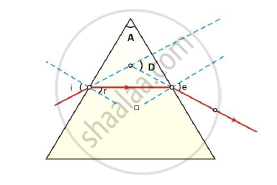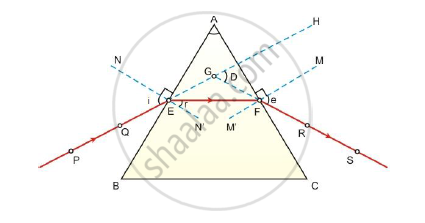Advertisements
Advertisements
प्रश्न
In the following ray diagram the correctly marked angle are:

(a) ∠i and ∠e
(b) ∠A and ∠D
(c) ∠i, ∠e and ∠D
(d) ∠r, ∠A and ∠D
उत्तर
(d) ∠r, ∠A and ∠D
The angle between the normal and the incident ray is the angle of incidence.
The angle between the normal and the emergent ray is the angle of emergence.
The correctly marked angles are shown in the diagram below:

APPEARS IN
संबंधित प्रश्न
What happens when a ray of ordinary light is passed through a triangular glass prism?
A beam of white light is shone onto a glass prism. The light cannot be:
(a) deviated
(b) dispersed
(c) focused
(d) refracted
Out of air and glass, which is optically rarer? Give reason.
What is the cause of the dispersion of white light through a glass prism? Draw a ray diagram to show the path of light when two identical glass prisms are arranged together in an inverted position with respect to each other and a narrow beam of white light is allowed to fall obliquely on one of the faces of the prisms.
Sunlight entering through a narrow aperture falls on a prism. Draw a neat labelled ray diagram to show the formation of the spectrum on a screen. Name the colour obtained nearer the base of the prism.
The process of separation of light into its component colours while passing through a medium is called _______.
The sunlight can be split into its constituent colors using ______.
Define dispersion of light.
A prism of refractive index `sqrt2` and refracting angle A produces minimum deviation δm of a ray on one face at an angle of incidence 45°, The values of A and δm are, respectively ______.
State the colour which bends:
- The most.
- The least while passing through a glass prism.
